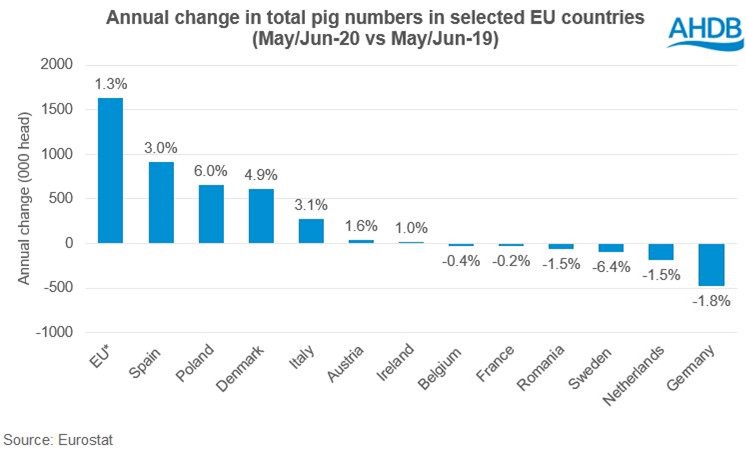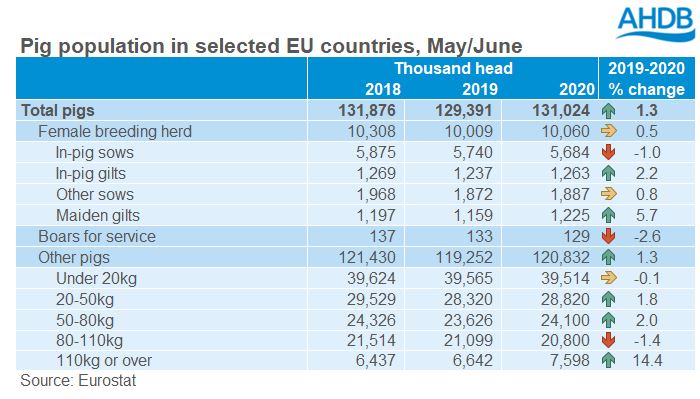A slight rise in the EU pig population
Thursday, 8 October 2020
By Bronwyn Magee
Figures from May/June agricultural surveys show a slight increase in the pig herd of participating EU nations. The total number of pigs in the EU member states carrying out the survey* increased marginally to 131 million head, up 1% year-on-year. This is according to provisional data from Eurostat. This follows a period of decline in EU pig populations, as outlined in the May/June census last year, though numbers had started to stabilise by last December.

As in the December census, pig numbers in Poland, Denmark and Spain have continued to grow, accounting for a large share of the increase across the continent. Spain was the largest contributor to an increase in overall EU numbers, up 911,000 head on the year.
Despite the threat of ASF, numbers in Poland also increased significantly, up 652,000 head (+6%). Poland also reported a 2% increase in pig numbers in the December census, but slaughter levels have actually been 8% down on 2019 levels during the first 6 months of the year. Pigs backing up on farm, due to disruption caused by the coronavirus pandemic, may offer some explanation. The situation may become clearer as slaughter figures for more recent months are released. It could also be that we need to treat either the Polish slaughter or census data with some caution.
The Dutch pig herd declined on the year (-185,000 head), perhaps a result of environmental regulations, which were enforced in January 2020. The population in Germany also continued to decline, (-479,000 head) likely influenced by increasing legal requirements, encouraging producers to exit the industry. With ASF now disrupting the country’s export prospects, it’s likely this downward trend is set to continue.
Looking in more detail, the EU* female breeding herd increased very slightly on the year to 10.1 million, up by 0.5%. Overall, a degree of growth came from both maiden and in-pig gilts. Notable declines came from Germany (-29,500 head) and Romania (-14,200 head), with ASF still taking a toll on Romanian production. However, growth in Poland (+40,000 head), Denmark (+23,000 head) and Spain (+16,700) outweighed this.
The number of pigs between 20-50kg increased on the year, up by 501,000 head. Pigs between 50-80kg also increased by 474,000 head. However, the largest increase to overall EU numbers was the number of pigs 110kg or over, up by 956,000 head on the year. This is probably the result of disruption to slaughter capacity and foodservice demand during the coronavirus pandemic, generating a backlog in pigs for slaughter.
What this might mean for production?
The heavier pigs recorded in this census will have been slaughtered by now, but modest growth in the number of younger pigs still points towards a slight increase in pork production in the latter part of this year. The coronavirus pandemic may continue to present a challenge for maintaining throughputs at abattoirs though.
Looking further forward, modest growth in the number of gilts in the EU breeding herd suggests some nations may be looking to expand production. This is particularly the case for Spain and Denmark, both exporting nations looking to capitalise on Chinese market opportunities, particularly as German herd numbers decline. The increased EU breeding herd size ought to boost production a little early next year.
Of course, the progression of ASF into the German wild boar herd will also influence how pig herds develop from here. If German exports remain impeded, this may well accelerate the herd decline there, but support growth in Spain and Denmark. Much depends on how well EU markets can readjust trade flows, and so how prices and profitability develop across member states. How well ASF spread is managed will also be influential. We will be closely monitoring all these developments as they unfold in the following months.
*The May/June agricultural survey is not conducted by all members states of the EU but covers 90% of the EU pig herd.
Sign up for regular updates
Subscribe to receive pork market news straight to your inbox. Simply complete our online form.
While AHDB seeks to ensure that the information contained on this webpage is accurate at the time of publication, no warranty is given in respect of the information and data provided. You are responsible for how you use the information. To the maximum extent permitted by law, AHDB accepts no liability for loss, damage or injury howsoever caused or suffered (including that caused by negligence) directly or indirectly in relation to the information or data provided in this publication.
All intellectual property rights in the information and data on this webpage belong to or are licensed by AHDB. You are authorised to use such information for your internal business purposes only and you must not provide this information to any other third parties, including further publication of the information, or for commercial gain in any way whatsoever without the prior written permission of AHDB for each third party disclosure, publication or commercial arrangement. For more information, please see our Terms of Use and Privacy Notice or contact the Director of Corporate Affairs at info@ahdb.org.uk © Agriculture and Horticulture Development Board. All rights reserved.


